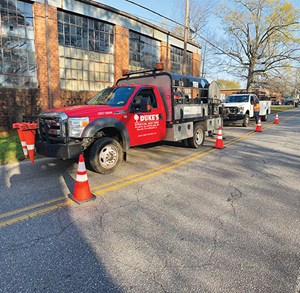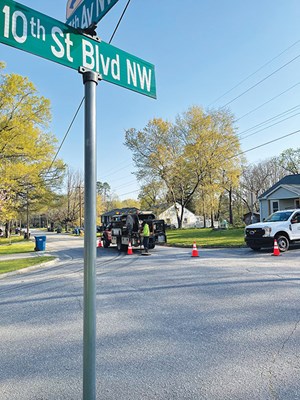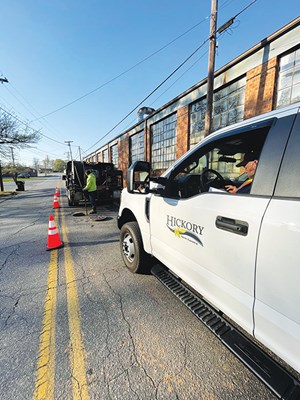July 2022 Vol. 77 No. 7
Rehab Technology
Asset Management: One Street at a Time
Jeff Griffin | Senior Editor
Hickory is a progressive city of 40,600 in North Carolina located at the foot of the Blue Ridge Mountains between Charlotte and Asheville. Mature hardwoods and evergreen trees contribute to the beauty of this pleasant southern city.
However, trees have elaborate root systems that invade sanitary sewer pipes and can clog or block sewage flow. Roots are a primary cause of sewer system overflows (SSOs).
It is virtually impossible to prevent roots from entering sewer lines because of the warm water and nutrients there. Hair-sized roots enter through joints and then grow.
Jetting and mechanically cutting roots from pipes are two options for clearing them, but both risk serious damage, especially to older pipes that have been in the ground for many years. Replacing a clogged sewer line is the most expensive and disruptive option
The original sewer collection system, primarily made of terra cotta pipe, was installed in 1904, said Shawn Pennell, Hickory public utilities director. Most of the pipe was installed in the 1930s and ’40s and was vulnerable to damage by root cutters.
“Since then,” Pennell said, “our system has grown substantially and only about 15 percent of terra cotta remains. Of that, only 5 percent of the original system still is in good operating service.”
New solution
Thirty-three years ago, the city took several lines off the root-cutting schedule and went another direction by applying chemical treatment every three years. The success of these continued chemical treatments led to the city making them the primary method of root control.
A good example of why the city switched to chemical root control is 10th Street Boulevard NW, one of the original conversions. More than 30 years after the first treatment, CCTV inspections showed the pipe to be in excellent condition, still an operational city asset.
“Shifting from mechanical cutting to chemical treating has been a true cost-saving measure for the city of Hickory,” said Pennell. “We very seldom perform root cutting any more, and when we do, that segment of line is added to the chemical treatment program, if it meets the criteria.”
Pennell pointed out that the primary benefit of chemical root control is cost. Treatments have reduced SSOs, labor to address them, and claims against the city, and prevented potential regulatory issues.
Duke’s Root Control provided treatment services when Hickory first tried chemical root control and continues to serve the city today.
Duke’s Razorooter is a diquat dibromide product. A Duke’s application crew consists of two men with a truck containing the chemical solution and a reel of hose. Chemicals are applied though a manhole and can either go up or downstream.
Application
Tillery said Razorooter is a chemical-laden, thick foam that has the consistency of heavy shaving cream. The Duke’s crew inserts a hose from manhole to manhole. The hose releases and sprays the foam in all directions, allowing it to adhere to roots and penetrate through wye connections to kill roots, even in lateral lines. Typically, each pipe treatment is about 300 feet, with 600 feet the maximum recommended distance.
“The entire system is treated as the foam compresses against pipe surfaces and penetrates cracks, joints and connecting sewers,” Tillery said. “This treatment kills roots on contact inside and outside the pipe walls. The roots then decay naturally and slough away, with regrowth delayed for two to three years.”
A Razorooter treatment does not harm trees and other abov- ground vegetation, and disruption to residents and businesses is minimal.
Currently Hickory’s sewer collection and treatment system consists of 498 gravity and 43 miles of force main pipes and three treatment plants. It serves 17,164 residential and commercial customers. UC
FOR MORE INFORMATION:
Duke’s Root Control, (800) 447-6687, dukes.com







Comments